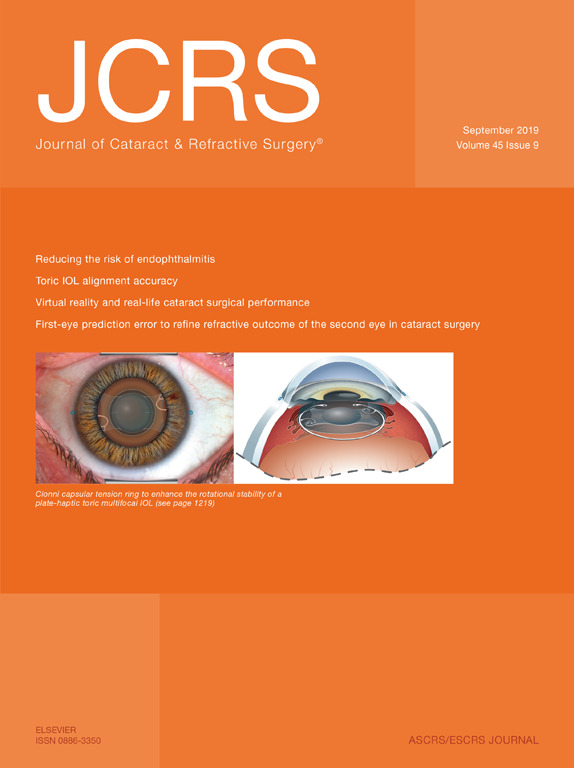JCRS Highlights - selected by Thomas Kohnen, European Editor, JCRS
Vol: 45 Issue: 9 Month: September 2019

Thomas Kohnen
Published: Tuesday, October 1, 2019
 Reducing endophthalmitis with moxifloxacin
Intracameral moxifloxacin prophylaxis significantly reduces postoperative endophthalmitis rates in various types of cataract surgery, including those with complications such as posterior capsule rupture (PCR), a study of more than two million cases indicates. That data came from a retrospective multi-centre clinical registry of 10 regional Aravind Eye Hospitals in India. The majority of these patients had manual small-incision cataract surgery (MSICS), with private patients having phacoemulsification surgery with a foldable IOL, and a few patients requiring manual extracapsular cataract surgery. Patients receiving moxifloxacin prophylaxis had an injection of 0.1mL containing 0.5mg of moxifloxacin into the anterior segment at the end of surgery. The was associated with a significant decline in the endophthalmitis rate, from 0.07% to 0.02%. This was independently significant for phacoemulsification and for MSICS. A Haripriya et al., JCRS, “Endophthalmitis reduction with intracameral moxifloxacin in eyes with and without surgical complications: Results from 2 million consecutive cataract surgeries”, Volume 45, Issue 9, 1226-1233.
Toric alignment without marking
Conventional corneal marking can lead to postoperative toric intraocular lens misalignment. Researchers evaluated the OPMI Lumera 700 microscope and CALLISTO eye cataract surgery for toric IOL alignment in 50 eyes of 50 patients. The image-guided system enabled “easy and exact toric IOL alignment”. The absolute difference between the aimed toric IOL axis and the positioned toric IOL axis after the IOL implantation was 0.52 ± 0.56 degrees (range 0.01 to 2.76 degrees). RM Varsits et al., JCRS, “Evaluation of an intraoperative toric intraocular lens alignment system using an image-guided system”, Volume 45, Issue 9, 1234-1238.
Using prediction errors to improve results
The primary limitation of intraocular lens power formulas today is the accurate prediction of the effective lens position (ELP). Formula-specific adjustments based on the prediction error (PE) of the first eye in cataract surgery can produce more accurate prediction of the ELP in the second eye, new research suggests. A retrospective study analysed 139 patients in Australia and 605 patients in the UK who underwent delayed sequential bilateral cataract surgery. The prediction error was determined by comparing postoperative subjective refraction with the predicted postoperative refraction calculated by the Barrett Universal II, Hoffer Q, Holladay I, and SRK/T formulas. Adjustment coefficients were derived for each formula and applied to the second eye’s IOL calculation. Separately, patient-specific optimised IOL constants were derived from the first-eye PE and applied to the second-eye calculation. Second-eye refinement via either method improved the percentage of patients achieving the refractive target with their second eye. A Turnbull et al. JCRS, “Using the first-eye prediction error in cataract surgery to refine the refractive outcome of the second eye”, Volume 45, Issue 9 1239-1245.
Reducing endophthalmitis with moxifloxacin
Intracameral moxifloxacin prophylaxis significantly reduces postoperative endophthalmitis rates in various types of cataract surgery, including those with complications such as posterior capsule rupture (PCR), a study of more than two million cases indicates. That data came from a retrospective multi-centre clinical registry of 10 regional Aravind Eye Hospitals in India. The majority of these patients had manual small-incision cataract surgery (MSICS), with private patients having phacoemulsification surgery with a foldable IOL, and a few patients requiring manual extracapsular cataract surgery. Patients receiving moxifloxacin prophylaxis had an injection of 0.1mL containing 0.5mg of moxifloxacin into the anterior segment at the end of surgery. The was associated with a significant decline in the endophthalmitis rate, from 0.07% to 0.02%. This was independently significant for phacoemulsification and for MSICS. A Haripriya et al., JCRS, “Endophthalmitis reduction with intracameral moxifloxacin in eyes with and without surgical complications: Results from 2 million consecutive cataract surgeries”, Volume 45, Issue 9, 1226-1233.
Toric alignment without marking
Conventional corneal marking can lead to postoperative toric intraocular lens misalignment. Researchers evaluated the OPMI Lumera 700 microscope and CALLISTO eye cataract surgery for toric IOL alignment in 50 eyes of 50 patients. The image-guided system enabled “easy and exact toric IOL alignment”. The absolute difference between the aimed toric IOL axis and the positioned toric IOL axis after the IOL implantation was 0.52 ± 0.56 degrees (range 0.01 to 2.76 degrees). RM Varsits et al., JCRS, “Evaluation of an intraoperative toric intraocular lens alignment system using an image-guided system”, Volume 45, Issue 9, 1234-1238.
Using prediction errors to improve results
The primary limitation of intraocular lens power formulas today is the accurate prediction of the effective lens position (ELP). Formula-specific adjustments based on the prediction error (PE) of the first eye in cataract surgery can produce more accurate prediction of the ELP in the second eye, new research suggests. A retrospective study analysed 139 patients in Australia and 605 patients in the UK who underwent delayed sequential bilateral cataract surgery. The prediction error was determined by comparing postoperative subjective refraction with the predicted postoperative refraction calculated by the Barrett Universal II, Hoffer Q, Holladay I, and SRK/T formulas. Adjustment coefficients were derived for each formula and applied to the second eye’s IOL calculation. Separately, patient-specific optimised IOL constants were derived from the first-eye PE and applied to the second-eye calculation. Second-eye refinement via either method improved the percentage of patients achieving the refractive target with their second eye. A Turnbull et al. JCRS, “Using the first-eye prediction error in cataract surgery to refine the refractive outcome of the second eye”, Volume 45, Issue 9 1239-1245.